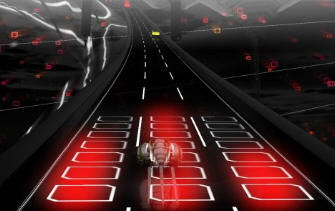 Audiosurf has been released on Steam using the Steamworks toolset, which also means the game will support achievements.
Audiosurf has been released on Steam using the Steamworks toolset, which also means the game will support achievements.
Audiosurf is a music-adapting puzzle racer developed by Invisible Handlebars where you use your own music to create your own experience. The shape, the speed, and the mood of each ride is determined by the song you choose. You control a levitating spacecraft (similar to F-Zero or Wipeout) with the goal of the game being to score points by collecting colored blocks (called ‘cars’) and forming clusters of 3 or more of the same color. The more blocks you accumulate in a cluster, the more points are scored, with hot colors (red, yellow) being worth more points than soft colors (blue, magenta) in the default color setting of the game.
Players are also awarded bonus points at the end of each track based on feats they achieved, such as finishing the song with no blocks left in the grid or collecting all the blocks of a certain color. You can also compete with others on the internet for the high score on your favorite songs.
Check out some beautiful screenshots of the game:

Audiosurf on Steam includes The Orange Box soundtrack. In addition, Audiosurf is one of the first titles to leverage the recently announced Steamworks, offering full support for the Steam Achievements that appear on Steam Community profile pages as mentioned above.
Game features include:
* Play with any music from your own collection–the game supports MP3s, iTunes M4As, WMAs, CDs and OGGs
* Valve’s The Orange Box Original Soundtrack is included.
* Online scoreboards for each song you play.
* Choose your strategy from 14 available characters.
* Track your progress as Steam Achievements.
* Only cost $10
Here’s a video of the game in action, set to the metal tunes of Dragonforces’s Through the Fire and Flames.
And here’s an interview with the Invisible Handlebar’s Dylan Fitterer, the game’s creator.
Question: What kind of background do you have in the game industry or in making games?
Fitterer: I’ve been building hobby games for about 10 years now. Early on my goal was to make the Best Game Ever! I then found out that goal was a bit lofty, and I wasn’t ending up with a finished product. So I went another route, producing lots of my own small games at a rapid pace just to get good ideas playable quickly. Audiosurf is a mix of these approaches – it grew out of one of my rapidly-prototyped games, but has been polished by years of work.
In addition to working on Audiosurf, I do contract work on serious games and web games.
Question: What motivated you to create a game like Audiosurf?
I’m hooked on the combination of technical and creative work involved in game development and basically can’t stop. I can’t pinpoint an exact moment I was inspired to create Audiosurf, but it came from my fascination with music visualizers. I wanted to merge a visualizer with gameplay to get more invested in it and sharpen my emotional response. Such a game could offer players limitless variety too.
Question: Where did you draw inspiration from in its design and implementation?
My biggest inspiration was the game Rez – the way it blended music and gameplay into a unified whole completely blew me away. I loved Rez, and thought it would be great to play something in that vein with my own songs. There was also a music visualizer from WildTangent with a ship flying above morphing terrain that sucked me in. That got me thinking about the potential of a 3D, perspective-view music visualizer.
Music is a constant inspiration to me too – I can hardly work without it. During development I kept coming back to songs that slowly build to explosion while thinking about how to heighten the resulting rush.
Question: What sort of development tools are used by the team?
I use VC++ for performance-critical stuff and library integrations. Rapid gameplay iterations are crucial to me, so I use Quest3D for everything else.
It’s easy for me to talk about Audiosurf at a high level now that it’s nearly done, but that’s not how I work. I follow my intuition and rapidly build almost every idea into a prototype. Tons of code gets tossed in the wastebin while the remaining bits are winners.
Question: What do you think the most interesting element of your game is?
The music processing engine is the single most interesting part of Audiosurf. It analyzes the entire song before play begins so the gameplay pacing and procedural geometry can be synchronized ahead of time. This way, Audiosurf can arrange geometry for a feeling similar to the Chemical Brothers’ Star Guitar video. Most importantly, this allows players to be able to select any piece of music to play within the game, not just pre-set choices: Audiosurf calculates how to accurately visualize any song you choose.
Audiosurf enhances the player’s emotional reaction to music, and also enhances the player’s anticipation. You can literally see the music coming at you.
What makes me really happy is how well the player’s color-matching goal enhances the visualizer. Making players an active part of the visualization (with a goal) focuses their awareness on the song’s upcoming changes and increases their immersion in the music. Because it’s a game, it’s a better visualizer, and because it’s a visualizer it’s a better game.
Question: Roughly how many people have been working on Audiosurf, and what has the development process been like?
Audiosurf came to life several years ago as a mp3-reactive FPS set on a morphing disco floor called Orchestrated Assault. That code eventually collapsed on itself. I hadn’t ever finished a game and I was inspired by the Indie Game Jam to try and do one quickly. That led to launching BestGameEver.com, where I released a new game every Friday for about 6 months. My favorite of these 7-day games was Tune Racer, and I ended up working with it until it became the Audiosurf of today.
Tune Racer went through many variations (and names) during this time. Different ideas included shooting enemies and racing through a forest at the speed of your music. I eventually came to the idea of pre-processing the player’s song and renamed it Audiosurf.
Once Audiosurf’s puzzle gameplay and the different character modes finally stabilized, I sought help with graphics, built-in music choices, and usability. It took a lot of searching, but talented people came on board and helped bring Audiosurf to the next level.
I couldn’t be happier with my wife Elizabeth’s user experience work, Paladin Studio’s 3D models, Goran Delic’s illustrations, Pedro Camacho’s musical score, and Albert Park and Flynn Joffray’s graphic design. I’ve integrated many great game ideas from the team including ideas from our core testers (Erik Fitterer and Kevin Egan) and our beta testers.
Question: If the team had to rewind to the very start of the project, is there anything that you’d do differently?
Knowing now what the finished Audiosurf is like, it could be built in much less time. Without hindsight though, I’m not sure it could have been created any other way.
Question: What are your thoughts on the state of independent game development, and are any other independent games out now that you admire?
It seems that every year lately is the best year ever for indie gaming. There’s tons of great tools, tons of bright people, tons of compelling games, and most recently, tons of distribution options. Some games that have really impressed me are: Kingdom Elemental: Tactics, Pax Galaxia, Counterclockwise, Echoes, Mount & Blade, and Gunroar.
Question: You have 30 seconds left to live and you must tell the game business something very important. What is it?
Go for it – try to make the best game ever! But remember to set some shorter goals along the way. — Interview via Gamasutra




